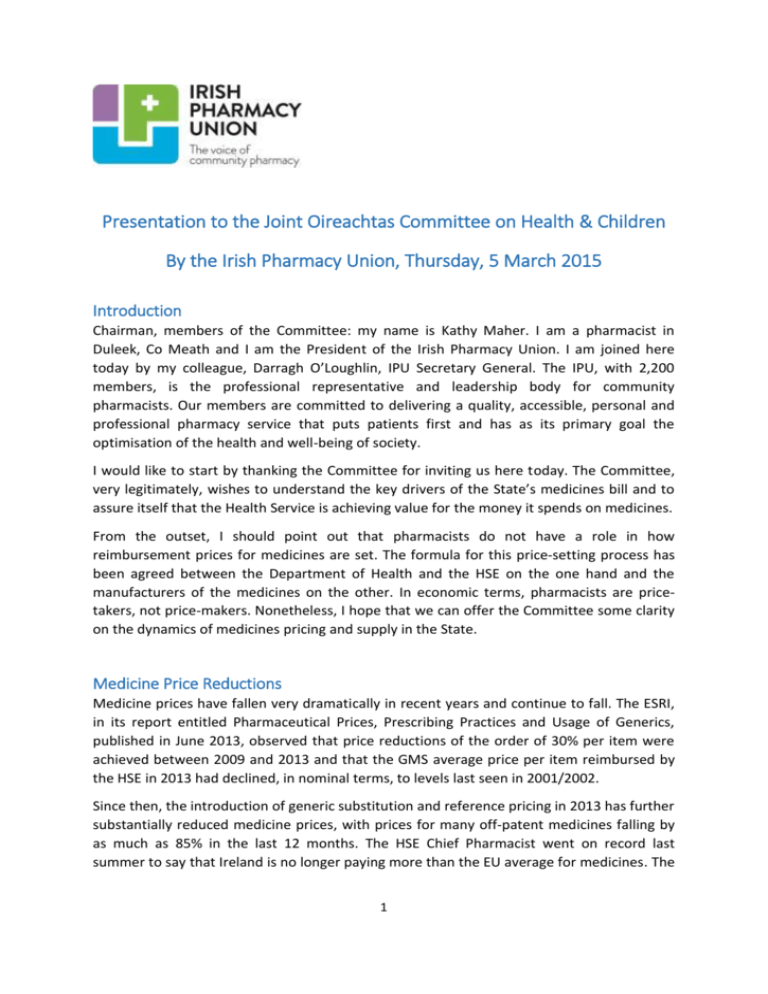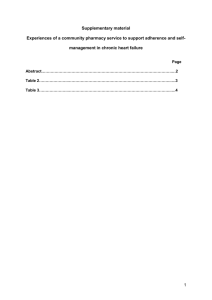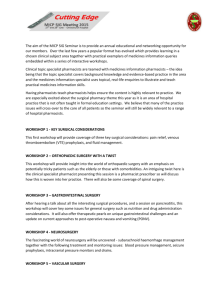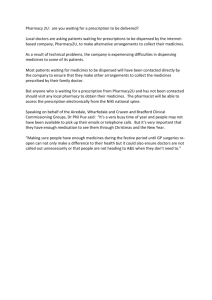Presentation to the Joint Oireachtas Committee on Health & Children
advertisement

Presentation to the Joint Oireachtas Committee on Health & Children By the Irish Pharmacy Union, Thursday, 5 March 2015 Introduction Chairman, members of the Committee: my name is Kathy Maher. I am a pharmacist in Duleek, Co Meath and I am the President of the Irish Pharmacy Union. I am joined here today by my colleague, Darragh O’Loughlin, IPU Secretary General. The IPU, with 2,200 members, is the professional representative and leadership body for community pharmacists. Our members are committed to delivering a quality, accessible, personal and professional pharmacy service that puts patients first and has as its primary goal the optimisation of the health and well-being of society. I would like to start by thanking the Committee for inviting us here today. The Committee, very legitimately, wishes to understand the key drivers of the State’s medicines bill and to assure itself that the Health Service is achieving value for the money it spends on medicines. From the outset, I should point out that pharmacists do not have a role in how reimbursement prices for medicines are set. The formula for this price-setting process has been agreed between the Department of Health and the HSE on the one hand and the manufacturers of the medicines on the other. In economic terms, pharmacists are pricetakers, not price-makers. Nonetheless, I hope that we can offer the Committee some clarity on the dynamics of medicines pricing and supply in the State. Medicine Price Reductions Medicine prices have fallen very dramatically in recent years and continue to fall. The ESRI, in its report entitled Pharmaceutical Prices, Prescribing Practices and Usage of Generics, published in June 2013, observed that price reductions of the order of 30% per item were achieved between 2009 and 2013 and that the GMS average price per item reimbursed by the HSE in 2013 had declined, in nominal terms, to levels last seen in 2001/2002. Since then, the introduction of generic substitution and reference pricing in 2013 has further substantially reduced medicine prices, with prices for many off-patent medicines falling by as much as 85% in the last 12 months. The HSE Chief Pharmacist went on record last summer to say that Ireland is no longer paying more than the EU average for medicines. The 1 reference pricing process has seen many more significant medicine price reductions since that statement was made. It is also worth noting that it is not only the Exchequer that is benefiting from these price reductions. In very challenging economic circumstances, pharmacists are passing on the reductions to their customers and patients, who are seeing the effect at the pharmacy counter as the cost of filling their prescriptions has fallen, often dramatically, and continues to fall. Community Drugs Schemes Our research suggests that, on average, 80% of a pharmacy’s dispensing comes under the various State schemes, including the GMS or Medical Card Scheme, the Drugs Payment Scheme and the Long Term Illness Scheme, all of which are funded by the HSE at rates set by the Minister for Health. The fees paid to pharmacists have been cut repeatedly in the last number of years. I will now briefly outline the payment system for pharmacists: For all State-funded medicines supplied to patients, pharmacists are paid the ingredient cost, without mark-up, plus a regressive flat fee. Regulations made in July 2009 under the Financial Emergency Measures in the Public Interest Act reduced the reimbursement price of medicines from 100% of invoice price to 91.8% and, at the same time, reduced the markup which had previously been paid on the Long Term Illness Scheme and the Drugs Payment Scheme from 50% to 20%. In July 2013, further regulations made under the same Act eliminated the mark-up completely, leaving pharmacists reliant on the dispensing fee alone. Since its inception, the GMS Scheme has never attracted a mark-up. Dispensing at a loss The reimbursement model is dependent on the ability of pharmacists to negotiate terms with their suppliers to subsidise payments from Government. However, in many cases, this is not possible and pharmacists can find themselves dispensing at a loss, a phenomenon which is increasingly frequent. In order to ensure that patients have timely access to vital medicines, pharmacists are regularly paying wholesalers more than the HSE reimburses them. Indeed, due to a recent change in pricing policy by one of the two remaining wholesalers, which now charges pharmacists 9% above the reimbursement price on the first €2,000 of monthly purchases, each pharmacy will effectively be subsidising the HSE to the tune of approximately €2,000 per year. Cuts in pharmacy payments It is estimated that, since 2009, there has been a minimum of €314m in savings to the State for pharmacy fees. In that period, a further €1.42bn in savings has been realised by the State in reduced payment for medicines, which has affected all stakeholders in the medicine supply chain, with pharmacists, wholesalers and manufacturers all impacted. 2 Medicine shortages As pharmacists’ fees are unrelated to the cost of the medicine dispensed, we have no interest in seeing high prices maintained. However, I would sound a note of caution: there is evidence to suggest that, as medicine prices get ever lower, medicine shortages are increasing. It is basic economics. We are a very small market in a global context and, if it is more advantageous for certain suppliers to export out of Ireland to other EU markets where prices are higher, they will do so – with the result that Irish patients experience a shortage of essential medicines. IPU research, conducted in August 2014, confirmed that there is a significant level of medicine shortages, with 99% of pharmacists confirming that they have noticed medicine shortages in the last 12 months and with over half (52%) believing that the health of their patients has been adversely affected or put at risk by medicine shortages. As such, we believe that a mechanism for price modulation needs to be found to balance the legitimate desire of the HSE to achieve lower prices against the need to ensure continuity of supply for Irish patients. Getting the most from our resources The objective of any review of expenditure on medicines must be to maximise value for money and to ensure best possible health outcomes for patients. While price is part of the equation, it is essential that patients get their medicines at the right time and are taking them correctly. Pharmacists are hugely important in this process and there is considerable scope to develop the services delivered by community pharmacists through a more comprehensive, structured and organised service. Switching more medicines from prescription-only to non-prescription status empowers patients to take better care of their own health, with the advice and support of their pharmacist. This allows the patient speedier access to appropriate treatment, saving the time and cost of a GP visit, while saving the State the cost of the medicine and freeing up GP time to deal with more complex cases. In addition, evidence from the UK demonstrates that introducing a New Medicines Service allows patients with chronic conditions to get more benefit from their medicines by identifying any problems early and by improving adherence to prescribed therapy through an initial consultation with the pharmacist and a structured follow-up. Patients who had NMS consultations from their community pharmacist were more likely to be taking their medicine or to seek help from their prescriber, compared with those who did not receive the service. Economic modelling showed that this service could increase a patient’s length and quality of life while costing the Health Service less, when compared with patients who did not receive the service. 3 Conclusion In conclusion, the cost of most medicines is falling and will continue to fall over the next number of years, and the public and the Exchequer will continue to see considerable savings on their medicines bills as a result. It is appropriate that the Committee should seek to ensure prudent use of resources and to secure maximum value for the heath budget. However, it must be recognised that, even as average medicine prices continue to fall, there will always be upward pressure on the State’s medicines expenditure as a result of an increase in the number of eligible patients and greater use of exceptionally high cost innovative medicines and biological medicines. In addition, pharmacists are legitimately concerned that constantly falling prices may, in some cases, worsen existing medicine shortages, with the consequent negative impact on their patients’ treatment. Lastly, optimising resources and patient care is fundamental to an efficient and effective healthcare system. Years of short-sighted cuts in pharmacy payments have undermined the profession’s capacity to deliver the badly-needed pharmacy-based services, which have been shown elsewhere to improve patient health outcomes and, simultaneously, reduce spending on healthcare. It is time now for the government to engage with us on a positive agenda for change, to deliver convenient, accessible and cost-effective healthcare through a currently under-resourced and under-utilised pharmacy profession. Chairman, members of the Committee, I would like to thank you very sincerely for your attention and would welcome any questions you may have. 4





